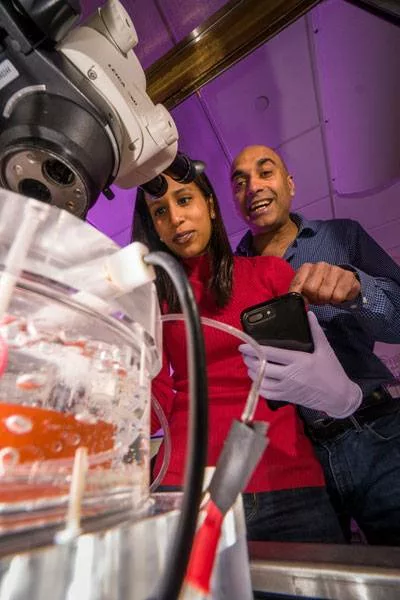“We found that patients with epilepsy show a deeper sleep than healthy controls, and that the depth of sleep is proportional to the amount of seizure activity during wakefulness preceding sleep — as if it were compensating for it,’’ says Maganti, who directs the UW Comprehensive Epilepsy Program and Electroencephalography Laboratory. “In contrast, epileptic spikes during sleep seem to decrease the efficiency of sleep.”
Boly, Tononi and Maganti published their findings in the journal Brain in April 2017. In 2015, Roopra received a Grace Grant, which was a game-changer for the way investigators in his laboratory study epilepsy. Using methods pioneered in cancer research, Roopra and his team, whose lab is now in WIMR II, took a deep dive into genomic data gleaned from 11 epilepsy laboratories around the world, sifting through 20,000 genes and looking for proteins that orchestrate the long-term changes in the epileptic brain, he explains.
That initial survey, funded with a $100,000 Lily’s Fund grant, generated data that allowed researchers in the Roopra lab to apply for and win two National Institutes of Health (NIH) R21 grants worth $275,000 each and a prestigious $250,000 Challenge Award from Citizens United for Research in Epilepsy.
Noting that data gleaned through research supported by Lily’s Fund helped the lab attain additional grants, Roopra says, “It really leap-frogged our research. A $100,000 grant is enough to prime the pump, and then everything else flows from it. The Lily’s Fund award came at the right time and allowed us to test our predictions.”
At the final Lily’s Luau, Roopra received a second $100,000 award, which is letting him further explore two master regulators of gene changes in epilepsy found in his research. One of them acts as a brake, protecting the brain from the damage of epilepsy. The other is an accelerator, driving pathological changes in the brain.
Meanwhile, Maganti received a second Grace Grant, along with Mathew Jones, PhD, an associate professor in the Department of Neuroscience, to look at how sleep deprivation triggers seizures. They also have applied for further NIH grants based on their Lily’s Fund work. Maganti’s recent research showed that epileptic mice in his lab suddenly die at a certain age, and he found in a study with his collaborator that rest periods (sleep periods) progressively decline prior to death in these mice, suggesting that sleep disruptions contribute to a dreaded complication of epilepsy known as “sudden unexplained death in epilepsy” (SUDEP).
Maganti and Jones’ Grace Grant-related work also showed that sleep deprivation in epileptic mice markedly worsens seizures or increases spikes on electroencephalograms (a signature of epilepsy), and their findings led to another NIH grant to study the basic mechanisms underlying sleep deprivationinduced seizures and how best these can be treated. They expect that this work will bring data from bench science to the epilepsy clinic.
“Seizures disrupt sleep, and disrupted sleep makes seizures worse,” Maganti told the Wisconsin State Journal in December 2017. “It can be sort of a vicious cycle.”
Maganti is hoping to study whether the use of medication to restore sleep can prevent SUDEP. These sudden deaths are likely triggered by seizures during sleep. Illustrating such a loss, a slide during the final Lily’s Luau paid homage to a young man with epilepsy, Jared Kimball, of McFarland, Wisconsin, who died in his sleep in 2017, just weeks after raising money at his workplace, Findorff Construction in Madison, to give to Lily’s Fund. As Kimball’s photo lit up the big screen, the words of Irish musician Glen Hansard reminded luau-goers that the fight continues:
“This gift will last forever,
This gift will never let you down …
If you’re strong enough,
And you don’t give up.”
Forever is a long time, but for years to come, Lily’s Fund certainly has elevated the profile of epilepsy research in School of Medicine and Public Health laboratories.
“To go from a few hundred dollars to fellowships, to grants of $100,000 and on to a research fund worth more than $1 million? I have never heard of this kind of success! It’s really a force of nature with these dedicated people,’’ exclaims Roopra. “Lily’s Fund made people aware that epilepsy is a major condition that is underfunded. I would have not pursued this line of research without Lily’s Fund. They were able to keep UW–Madison researchers on track and keep them in epilepsy research. Lily’s Fund deflected the trajectory of labs toward the study of epilepsy. That’s a major achievement!”





